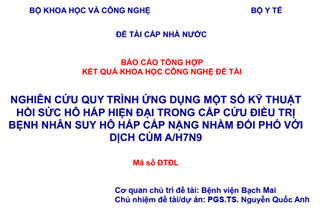Ventilator-associated respiratory infection in a resource-restricted setting: impact and etiology
Chi tiết nội dung bài báo vui lòng xem thêm tại đây: https://www.ncbi.nlm.nih.gov/pmc/articles/PMC5738227/
Abstract
Background: Ventilator-associated respiratory infection (VARI) is a significant problem in resource-restricted intensive care units (ICUs), but differences in casemix and etiology means VARI in resource-restricted ICUs may be different from that found in resource-rich units. Data from these settings are vital to plan preventative interventions and assess their cost-effectiveness, but few are available.
Methods: We conducted a prospective observational study in four Vietnamese ICUs to assess the incidence and impact of VARI. Patients ≥ 16 years old and expected to be mechanically ventilated > 48 h were enrolled in the study and followed daily for 28 days following ICU admission.
Results: Four hundred fifty eligible patients were enrolled over 24 months, and after exclusions, 374 patients’ data were analyzed. A total of 92/374 cases of VARI (21.7/1000 ventilator days) were diagnosed; 37 (9.9%) of these met ventilator-associated pneumonia (VAP) criteria (8.7/1000 ventilator days). Patients with any VARI, VAP, or VARI without VAP experienced increased hospital and ICU stay, ICU cost, and antibiotic use (p < 0.01 for all). This was also true for all VARI (p < 0.01 for all) with/without tetanus. There was no increased risk of in-hospital death in patients with VARI compared to those without (VAP HR 1.58, 95% CI 0.75–3.33, p = 0.23; VARI without VAP HR 0.40, 95% CI 0.14–1.17, p = 0.09). In patients with positive endotracheal aspirate cultures, most VARI was caused by Gram-negative organisms; the most frequent were Acinetobacter baumannii (32/73, 43.8%) Klebsiella pneumoniae (26/73, 35.6%), and Pseudomonas aeruginosa (24/73, 32.9%). 40/68 (58.8%) patients with positive cultures for these had carbapenem-resistant isolates. Patients with carbapenem-resistant VARI had significantly greater ICU costs than patients with carbapenem-susceptible isolates (6053 USD (IQR 3806–7824) vs 3131 USD (IQR 2108–7551), p = 0.04) and after correction for adequacy of initial antibiotics and APACHE II score, showed a trend towards increased risk of in-hospital death (HR 2.82, 95% CI 0.75–6.75, p = 0.15).
Conclusions: VARI in a resource-restricted setting has limited impact on mortality, but shows significant association with increased patient costs, length of stay, and antibiotic use, particularly when caused by carbapenem-resistant bacteria. Evidence-based interventions to reduce VARI in these settings are urgently needed.
Bình luận
Tin tức khác
THÔNG TIN BÁO CÁO KẾT QUẢ ĐỀ TÀI KHCN CẤP NHÀ NƯỚC 2020
ĐỀ TÀI KHCN CẤP NHÀ NƯỚC BỆNH VIỆN BẠCH MAI 2020: NGHIÊN CỨU QUY TRÌNH ỨNG DỤNG MỘT SỐ KỸ THUẬT HỒI SỨC HÔ HẤP HIỆN ĐẠI TRONG CẤP CỨU ĐIỀU TRỊ BỆNH NHÂN SUY...
| Đang online: | 14 |
| Lượt truy cập trong ngày: | 267 |
| Tổng số lượt truy cập: | 1891543 |






